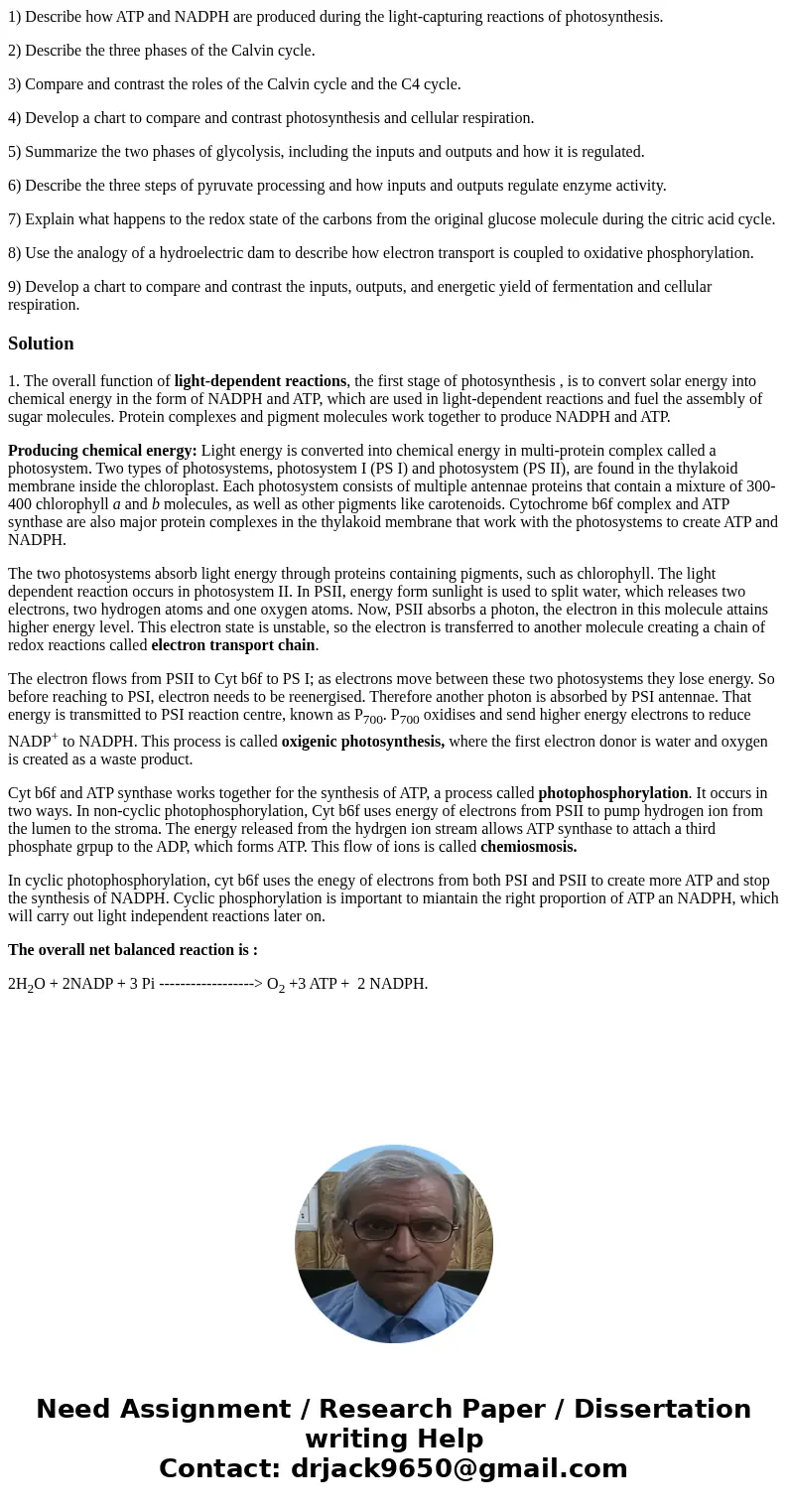1 Describe how ATP and NADPH are produced during the lightca
1) Describe how ATP and NADPH are produced during the light-capturing reactions of photosynthesis.
2) Describe the three phases of the Calvin cycle.
3) Compare and contrast the roles of the Calvin cycle and the C4 cycle.
4) Develop a chart to compare and contrast photosynthesis and cellular respiration.
5) Summarize the two phases of glycolysis, including the inputs and outputs and how it is regulated.
6) Describe the three steps of pyruvate processing and how inputs and outputs regulate enzyme activity.
7) Explain what happens to the redox state of the carbons from the original glucose molecule during the citric acid cycle.
8) Use the analogy of a hydroelectric dam to describe how electron transport is coupled to oxidative phosphorylation.
9) Develop a chart to compare and contrast the inputs, outputs, and energetic yield of fermentation and cellular respiration.
Solution
1. The overall function of light-dependent reactions, the first stage of photosynthesis , is to convert solar energy into chemical energy in the form of NADPH and ATP, which are used in light-dependent reactions and fuel the assembly of sugar molecules. Protein complexes and pigment molecules work together to produce NADPH and ATP.
Producing chemical energy: Light energy is converted into chemical energy in multi-protein complex called a photosystem. Two types of photosystems, photosystem I (PS I) and photosystem (PS II), are found in the thylakoid membrane inside the chloroplast. Each photosystem consists of multiple antennae proteins that contain a mixture of 300-400 chlorophyll a and b molecules, as well as other pigments like carotenoids. Cytochrome b6f complex and ATP synthase are also major protein complexes in the thylakoid membrane that work with the photosystems to create ATP and NADPH.
The two photosystems absorb light energy through proteins containing pigments, such as chlorophyll. The light dependent reaction occurs in photosystem II. In PSII, energy form sunlight is used to split water, which releases two electrons, two hydrogen atoms and one oxygen atoms. Now, PSII absorbs a photon, the electron in this molecule attains higher energy level. This electron state is unstable, so the electron is transferred to another molecule creating a chain of redox reactions called electron transport chain.
The electron flows from PSII to Cyt b6f to PS I; as electrons move between these two photosystems they lose energy. So before reaching to PSI, electron needs to be reenergised. Therefore another photon is absorbed by PSI antennae. That energy is transmitted to PSI reaction centre, known as P700. P700 oxidises and send higher energy electrons to reduce NADP+ to NADPH. This process is called oxigenic photosynthesis, where the first electron donor is water and oxygen is created as a waste product.
Cyt b6f and ATP synthase works together for the synthesis of ATP, a process called photophosphorylation. It occurs in two ways. In non-cyclic photophosphorylation, Cyt b6f uses energy of electrons from PSII to pump hydrogen ion from the lumen to the stroma. The energy released from the hydrgen ion stream allows ATP synthase to attach a third phosphate grpup to the ADP, which forms ATP. This flow of ions is called chemiosmosis.
In cyclic photophosphorylation, cyt b6f uses the enegy of electrons from both PSI and PSII to create more ATP and stop the synthesis of NADPH. Cyclic phosphorylation is important to miantain the right proportion of ATP an NADPH, which will carry out light independent reactions later on.
The overall net balanced reaction is :
2H2O + 2NADP + 3 Pi ------------------> O2 +3 ATP + 2 NADPH.

 Homework Sourse
Homework Sourse